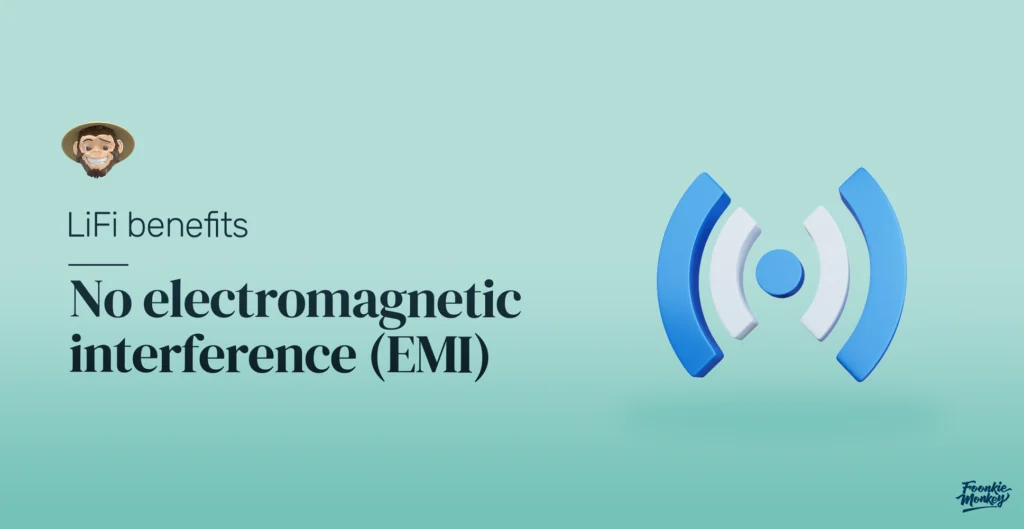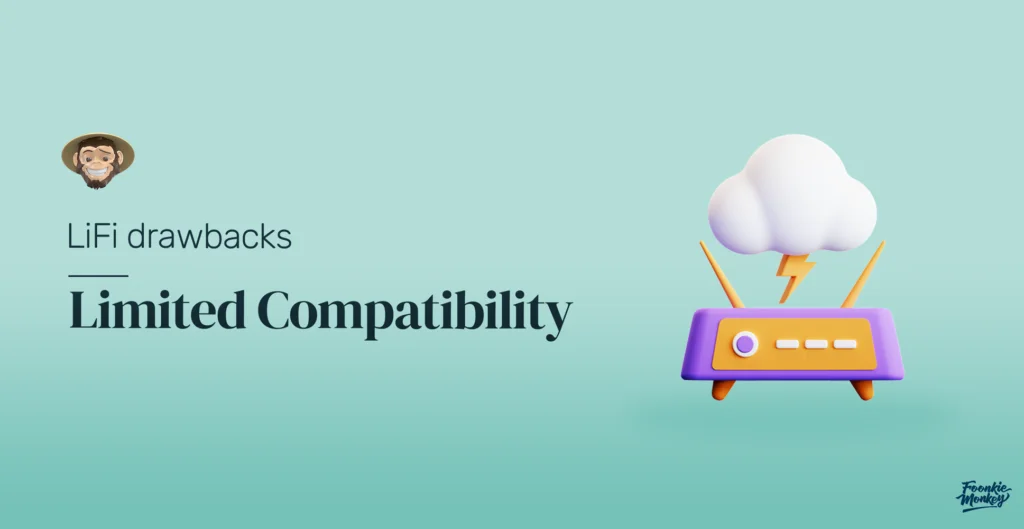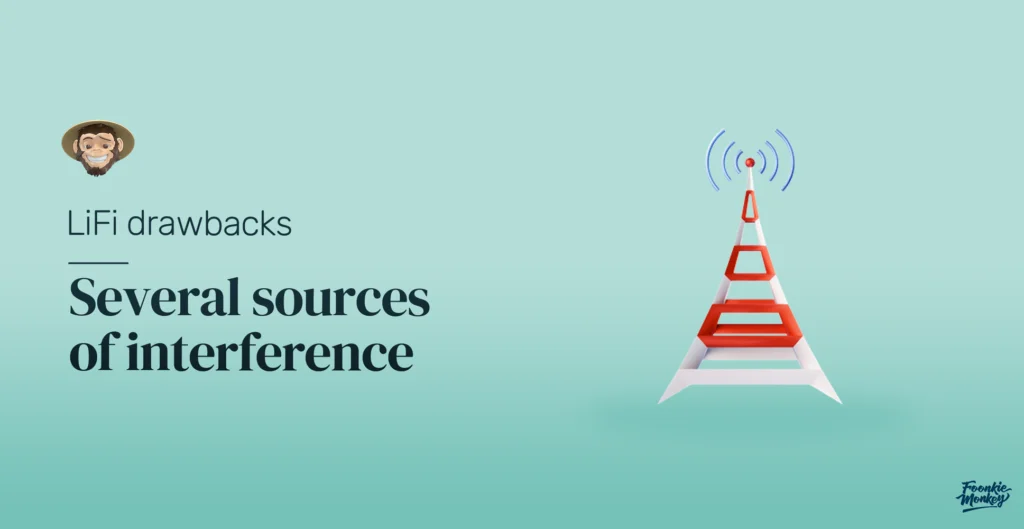Mobile networks are evolving rapidly, and our mobile and smart devices demand more capacity and higher speeds. As a result, LiFi, a robust, innovative communication technology, emerged as an alternative to how we access and use mobile networks.
Long gone are the days when we depended on dial-up connections and cable internet to access our favorite content and interact with online services. It seemed “Kubrickesque” at the time to think of any other way of using the internet that didn’t have us tethered to a cable. Still, shortly after, mobile technologies surfaced and changed the online world forever. There was no going back; mobile was here to stay. Now, Internet use is exploding, with 5 billion global worldwide web surfers as of April 2022; that’s 63% of the world’s total population! What’s more, 54% of that traffic comes from mobile devices, and over 92% of global users access internet services via Wi-Fi using a mobile phone. Needless to say, the volume of the international mobile data communication traffic is growing exponentially, and the number of connected devices keeps increasing, making us wonder if the current mobile network setup is fit to keep up with such growth. Enter LiFi.
So, even when it’s clear that WiFi runs our life and it’s the predominant wireless network, the truth is that the popular technology has its flaws. No matter where you live or where you connect from, we’ve all experienced a myriad of connectivity issues such as low speed or long buffering times at one point in our IT-driven lives. The good news is that however necessary and valuable WiFi has been for the 25+ years since it became commercially available, there are now more mobile connectivity options that are just as cutting-edge and disruptive as the quintessential network once was. One of those technologies is called LiFi.
Today, we at Foonkie Monkey want to tell you all about what LiFi is, how it works, how it differs from WiFi, and its benefits, applications, and drawbacks. Let’s begin.

What is LiFi?
LiFi, or Light Fidelity, is a wireless optical communication technology that, unlike WiFi (Wireless Fidelity) which uses radio waves, employs the clear, visible, ultraviolet, and infrared light spectrums to transmit data. In simpler terms, we can say that LiFi is a light-based WiFi that leverages the light spectrum, not radio waves, to transmit information. LiFi uses standard light-emitting diode (LED) light bulbs to share information at high speeds that travel up to 100 times faster than a conventional WiFi network. The term was coined for the first time by Professor Harold Haas, who, in his 2011 TED talk on Visible Light Communication (VLC), made a Li-Fi demonstration and introduced his concept of “wireless data from every light.” In short, VLC is a wireless communications protocol that uses modulated light intensity to enable high-speed data transmission. LiFi uses this basic principle of VLC but with an added two-way network protocol that facilitates high-speed network connectivity. Additionally, the fact that LiFi uses light to transmit data gives it an edge over WiFi, allowing it to have higher bandwidths and transmission speeds. It also helps it work flawlessly in areas with electromagnetic interference, such as airplane cabins where WiFi doesn’t function too well.
While it’s yet to reach broad coverage and wide commercial use, the LiFi market exceeded the $70 million mark in 2019 and should grow at a CAGR of over 50% between 2020 and 2030. The healthcare sector is where LiFi usage is thriving the most, with a total global revenue of $28.4 million in 2017, a figure that is projected to grow to reach $12.67 billion by 2028. These numbers corroborate LiFi’s huge potential to greatly impact mobile technologies and disrupt the way we access mobile networks and use our mobile devices. Moreover, LiFi also has the potential to revolutionize software and app development, especially for companies that specialize in mobile products and IoT solutions or any IT-powered products whose performance largely depends on efficient and fast mobile network connections. And, since LiFi uses lighting technology as its medium for data transfer, it promises to become a fundamental asset for the smart home of the future.

How does LiFi work?
Imagine instantly connecting to your home’s high-speed internet network simply by flicking on your lights. Sounds far-fetched, we know. However, that’s what LiFi promises. Currently, most of our homes are WiFi hotspots, meaning we use the radio spectrum to access the Internet. However, our beloved WiFi has its drawbacks. The radio spectrum is limited, has little room to grow, and is easily affected by electromagnetic signals present in some areas. In addition, these signals transmitted by some electronic devices often use the same radio waves as WiFi networks, meaning data transmission can slow down, the network’s throughput can be affected, and the connection’s performance can be significantly reduced. This phenomenon can be frustrating and affect the quality and performance of mobile and IoT applications designed to perform at optimal speeds.
LiFi doesn’t need the radio spectrum to transmit data, has faster transmission speeds, and fends off electromagnetic interference. Instead, it uses the light from LED bulbs and lamps to form a wireless network. But how?
LiFi bulbs have a chip embedded in them that modulates the light they emit and prepares it for optical data transmission. These LED bulbs emit pulses of light and are conduits for electrical currents. When you turn them on, an electrical current goes through them, releasing a stream of light. Note that LED bulbs can transform the intensity of this light at extremely high speeds, faster than the human eye can see. This change in intensity serves as a signal that has data embedded in it and can move information all the way to LiFi devices, such as tablets or smartphones. Think of it as a form of light-based Morse code where the intensity changes transmit binary data via flickers that we can’t see but happen at unfathomable speeds.
This signal is then received by the device, which interprets the intensity changes in the light stream and translates them into usable data. Afterward, the device sends its own light stream with data back to the LED bulb using invisible, infrared light. This bi-directional process happens at unimaginable speeds and is the reason why LiFi has the capacity to enable high-speed wireless communications. Actually, LiFi can transmit data at speeds that can go as high as 224 Gbps! That’s almost 100 times faster than the world’s fastest WiFi, also known as WiGig. Lastly, note that when the LED bulb is on, it transmits a digital 1. When it is off, it transmits a digital 0.
LiFi benefits
Okay, that all sounds great and all, but why should we let it into our homes? What exactly are the benefits of LiFi? Let’s find out.

High speed
What is the most critical connectivity requirement that we demand when accessing wireless networks? Speed. Long buffering times and low-speed connections are a hassle, and we’ve become so demanding that a slow network just doesn’t cut it anymore. As we mentioned earlier, WiFi uses radio frequencies for data transmission. However, the radio spectrum is finite and has no room to grow, meaning it will eventually become too crowded. The demand will overwhelm the network to the point where connections are too slow, and it won’t be possible to even access online content anymore. This phenomenon is known as spectrum crunch.
On the contrary, since LiFi uses light as a data conduit, it enables near-instant connections because, as we all know, light travels at immeasurably high speeds. These connections allow data to travel faster and result in higher internet speeds. In fact, the visible light spectrum ranges from 428 THz to 750 THz, which is about ten thousand times larger than the 300GHz of the radio spectrum. As a result, LiFi has access to a more extensive frequency range that covers frequencies from 430,000 to 770,000 GHz. LiFi also covers light spectrum colors from near ultraviolet to near-infrared.

Increased security
Radio wave signals have the ability to pass through walls, meaning that anyone with malicious intentions outside your home, office, etc., can easily intercept them and access your network and your information. As a result, WiFi connections, even when shielded appropriately, can be highly insecure. With LiFi, the opposite happens because light cannot pass through walls. Instead, it bounces off all solid, opaque, and dense surfaces, meaning that none of the data transmitted through LiFi can travel outside an enclosed space. As a result, any information you store and share or any data that travels via your LiFi network is secure. You can simply turn any room you want into a high-security area when using vulnerable devices and dealing with sensitive data and use your regular WiFi network in common areas when you’re not too worried about data safety.

No electromagnetic interference (EMI)
EMI is an obstruction in the path of an electrical circuit caused by an external source via electromagnetic induction, electrostatic coupling, or conduction. EMI hurts the performance and flow of the circuit to the point where it can completely stop it from working altogether. In the case of a WiFi network, EMI’s effects on data transmission can cause an increase in error rate, lower the network’s speed, or even cause a complete data loss or connection failure. Sources of EMI include natural phenomena such as solar flares or thunderstorms or man-made devices such as microwaves or cellphone networks.
As we already touched on, WiFi uses radio frequencies for data transmission. As a result, the popular wireless protocol is highly susceptible to electromagnetic interference. Even in a household environment, EMI can come from heating your coffee in your microwave, using your Bluetooth speaker, or calling your mom on your cordless telephone. Although in most cases, EMI is usually resolved by turning off the source of the interference or repositioning your router, it’s still a hindrance you won’t encounter using LiFi.
Since LiFi leverages light beams for data transfer, its performance and speed aren’t affected by EMI. In fact, the more light you use, the faster and better your connection will be. Why? Because–as we explained earlier–unlike WiFi’s radio frequency, which uses an unlicensed, limited, and finite radio spectrum of about 300 GHz, LiFi functions on a spectrum ten thousand times larger than that and doesn’t need an EMI-susceptible electrical circuit to work. For this reason, LiFi is the preferred protocol in healthcare settings and airplanes where EMI could interfere with device connectivity and be potentially dangerous. More on this later.

High availability
Light is a pervasive part of our everyday lives. It is everywhere, especially in our homes and workplaces; there’s a light source in virtually every room and corner of our preferred enclosures. Due to its nature, as long as you have an LED light source, you can connect to the internet using your LiFi network wherever you are. Not only that, but LED lights are available everywhere. They are moderately inexpensive light sources, meaning they are reasonable to purchase and install, making LiFi highly accessible and open to anyone.
Moreover, LED bulbs and lamps are way more energy productive and environmentally friendly than traditional bulbs and fluorescent lights. So, even if the need arises to keep them on to continue sending information for long periods of time, there’s no significant energy expenditure or environmental impact. As a result, their use can become widespread without raising additional concerns about availability, costs, or high energy requirements.
It’s important to note that, even though LiFi has high availability, for now, the technology is only available via LED bulbs and lamps. However, in the future, more extensive light sources such as street or building lights will be able to carry LiFi beams to help entire cities go online and stay connected everywhere.
LiFi drawbacks
Although LiFi is the answer to many of WiFi’s most common connectivity issues, it is still a relatively young technology that’s yet to experience massive growth, availability, and adoption. It has the potential to revolutionize wireless connectivity in the coming years, but in the meantime, the technology has some drawbacks that are worth noting.

Limited compatibility
It seems like today, every single piece of IT-powered gadget has WiFi compatibility. Actually, WiFi compatibility appears to be non-negotiable, and we demand it to fulfill our internet-fueled needs. But, on the contrary, since LiFi is still taking its first steps towards massive availability and global implementation, there aren’t too many devices in the market that are compatible with it. The reason behind this is that, for a device to be able to receive, read, and translate data from a LED source, it must be equipped with a photodiode that can interpret LiFi light signals. But unfortunately, most electronic devices on the market use hardware for WiFi compatibility only and don’t have photodiodes.

Several sources of interference
Sadly, and despite all its benefits, LiFi’s connectivity and outstanding speeds can be easily thwarted by several sources of interference. For one, as we already discussed, light cannot penetrate walls or solid surfaces, which means LiFi’s signal range is limited by the physical characteristics of any enclosure. Second, LiFi-based internet cannot function without a LED light source, meaning it is useless without the proper equipment and locational modifications. As a result, the areas and situations in which Li-Fi could work are reasonably limited. In some cases, considerable infrastructural changes will need to be made for it to work at a large scale.
Lastly, LiFi’s signal is highly susceptible to interference from outside factors such as other sources. The photodiodes from LiFi-enabled devices can also pick up light from several light sources, such as sunlight, that can compete with the LED beam. As a result, the receiver creates noise and causes disruptions in the signal.
LiFi applications
Well, there you have them, LiFi’s unique benefits and drawbacks. While both aspects of the technology are worth considering, its benefits give it an edge that far outweighs its constraints. However, it may seem like LiFi still has a narrow window of usability and low coverage, which may be the case right now, but it likely won’t remain that way for long. In the meantime, these are some of LiFi’s most popular use cases.

Hospitals
Healthcare is one of the industries where LiFi has the highest potential to really shine, mostly because hospitals are a hotspot for issues such as EMI sensitivity and data security. For one, healthcare workers can leverage LiFi to simplify patient monitoring via wireless sensors and IoMT devices without worrying about EMI from hospital equipment like MRI or other imaging and monitoring machines. In addition, in operating rooms, where WiFi isn’t allowed and installing optical fiber cables or wiring can be cumbersome, clinicians can use LiFi to operate devices and machines critical for successful procedures efficiently. Also, in places such as corridors and waiting rooms, Li-Fi technology can be the foundation of a light-based communication network that isn’t fazed by EMI or slow wireless networks caused by high connection traffic.
On the other hand, since hospitals deal with a constant flux of highly sensitive and confidential medical and personal data, they need a failsafe to guarantee this information is always protected. Usually, they turn to cyber security assurances that are very robust and effective but are also WiFi-based. As we already discussed, WiFi radio waves can be easily intercepted and hacked. These vulnerabilities aren’t present in light-based communications. As a result, LiFi can significantly enhance data protection protocols and promote the deployment of more secure networked medical institutions.
Here are the findings of a study where researchers wanted to transmit signals from an EEG (electroencephalograph) machine over 50 centimeters using a VLC-based communication system.

Pharma
In the pharma industry, Li-Fi technology could help promote the security and integrity of any sensitive medical data that travels within pharmacies. It could also encourage safer and more effective receiving and screening of electronic prescriptions directly inside pharmacies, as well as real-time monitoring of prescribed drugs. It can also promote the automation of processes such as inspection, manufacturing, and packaging for pharma companies that use WiFi-based technologies. This change to LiFi can lead to more efficient operations, reduced repetitive tasks, less overhead costs, and fewer human error margins.
Aviation
Airplane WiFi is great! Said no one ever. That’s because high-quality WiFi connections in both aircrafts and airports are either really expensive or hard to implement, especially for large airplanes with hundreds of passengers logging in simultaneously. Alternatively, airlines and airports could leverage the hundreds of light bulbs already present in most modern aircrafts and use them to create a LiFi network that can provide more reliable, less costly wireless connections. As a result, passengers would be able to access the internet via secure, fast, and reliable LiFi connections that wouldn’t be interrupted.

Education
It’s undeniable that modern learning experiences are internet-based. However, not all institutions have the correct wireless network to provide meaningful learning experiences. In educational settings, WiFi networks can get crowded and hinder crucial educational processes. LiFi can be exceptionally useful in addressing these connectivity issues. It can provide a stable and reliable connection between students and teachers. Furthermore, it can help establish communication avenues using intelligent technologies such as tablets and smartphones that can easily connect to light sources. As a result, LiFi can solve WiFi network connectivity issues and guarantee secure internet connections throughout entire schools and university campuses, which is the case in some institutions, such as the Hegel-gymnasium in Stuttgart, where they implemented LiFi connections in classrooms.

Final word
Light is a powerful resource. It can define how we experience the world around us. It provides recreational, educational, and health benefits that would be otherwise impossible to enjoy in a lightless world. However, it is sometimes underused, as is the case with LiFi. Although the technology is still in its early stages and its commercial success is still a long way off, it’s clear that LiFi promises to deliver significant advancements in terms of connectivity in years to come. In the meantime, LiFi is becoming increasingly valuable for various settings. As it is being tested, it clearly promises to solve radio spectrum, EMI, and many environmental issues, leading to a future with greener, more sustainable, and safer networked communications.
Looking at it now, saying that LiFi is the new WiFi seems like a stretch. But as the technology advances and we start seeing more successful real-life use cases, we can begin to trust in it and confidently say that LiFi will eventually give WiFi a run for its money.
If you have any questions about LiFi or want to work with us on your upcoming project, don’t hesitate to contact us so we can get started today!
